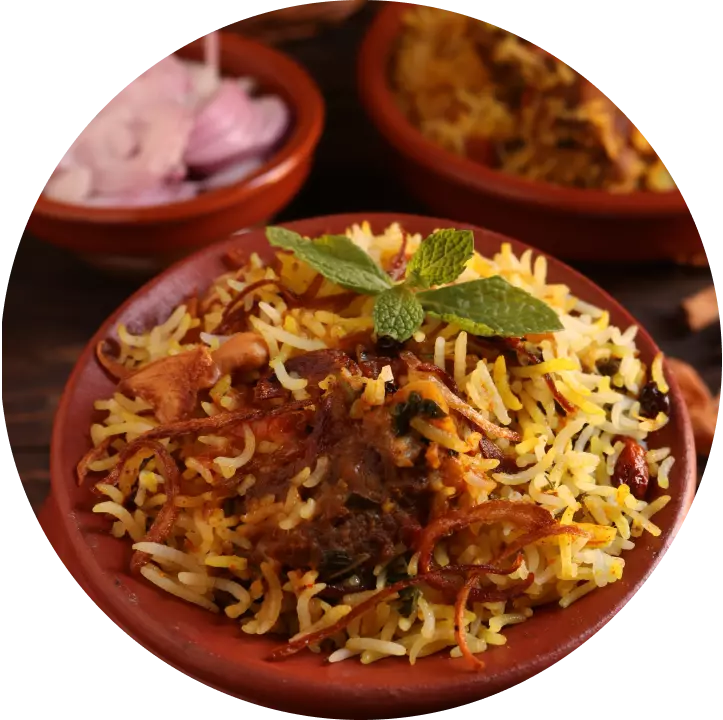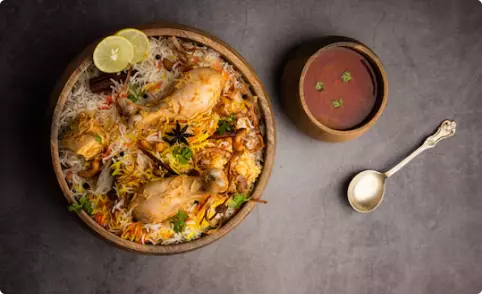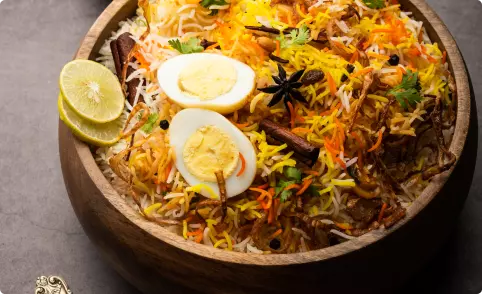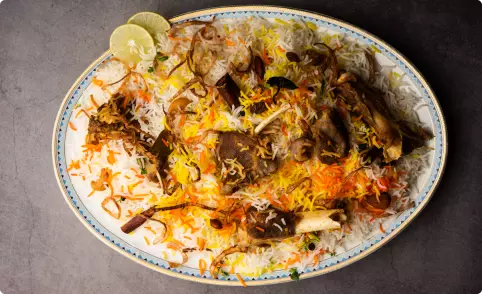Biryani
- Category: Rice
- Course: Main course
- Region or state: Indian subcontinent, Western Asia, Central Asia, Southeast Asia, Caribbean
- Main Ingredients: Rice, spices, meat/vegetables
- Variations: Chicken Biryani, Mutton Biryani, Egg Biryani, Hyderabadi Biryani, Bombay Biryani, Vegetable Biryani, Paneer Biryani etc.

Biryani, a word that is enough to make people drool, is a mixed rice dish scented with a complex concoction of spices and is originating among the Muslims of the Indian sub-continent. It is prepared with an array of Indian spices, rice, and usually some type of meat (chicken, beef, goat, lamb, prawn, fish) or in some cases with vegetables or eggs. Biryani is one of the most popular and most ordered dishes on food ordering platforms in India and is loved among the diaspora from the region as well. Made in different variations and with different spices in the countries such as Iraq, Thailand, Singapore, and Malaysia, Biryani is not only a meal but a pot of happiness for several foodies around the world.
The name ‘biryani’ is theorized to have been originated from the Persian word ‘birinj’ which means rice or the Persian word ‘biryan’ or ‘beriyan’ which means ‘to fry’ or ‘to roast’. Though the exact origin of the dish is uncertain in India it is enjoyed in different variations depending on the region. In the Muslim centers of North India, Biryani is relished in Delhi as Mughlai cuisine, in Rampur, Lucknow as Awadhi cuisine, and in other such small principalities. In South India, several delicious varieties of Biryani emerged from Hyderabad Deccan as well as Tamil Nadu (Ambur, Thanjavur, Chettinad, Salem, Dindigal), Kerala (Malabar), Telangana, and Karnataka (Bhatkal) where Muslim communities were in existence. According to some food historians, biryani developed in Persia and was brought to India by the Mughals, while some other food historians believe that Biryani developed in the royal kitchens of the Mughal Empire and is a modernized version of the native spicy rice dish of India and Persia called Pilaf or Pulao. A dish which is made aromatic and flavorful with a complex and dense concoction of spices and condiments and tastes heavenly in the palate, Biryani is a sinful meal which requires your utmost attention and dedication in its creation but is worth every effort.


Making of Biryani
Ingredients of Biryani differ from region to region and the type of meat or vegetables being used. While meat (goat, lamb, beef, chicken, prawn, fish) is primarily used in making of biryani, a vegetarian or eggetarian version is also there to satisfy people with varied preferences. The spices and condiments used in biryani mainly include fennel seeds, cloves, cinnamon, green cardamom, black cardamom, bay leaf, black peppercorn, ghee, onions, mint leaves, coriander leaves, tomatoes, ginger, garlic, chilies, and saffron. The dish can be accompanied with curd chutney, raita, korma, or curry.
There are two ways of making a biryani; Pakki biryani and Kacchi Biryani. In Pakki Biryani, meat or vegetables are marinated for some time and then partially cooked with a base of onions, tomatoes, and spices. Rice is soaked for an hour and then par cooked with flavored water from condiments. These ingredients are then layered and combined and cooked on dum to allow the flavors to blend for some more minutes. The layers can be topped with fried onions, saffron water, or mint leaves to enhance the flavor and aroma.
The Kacchi Biryani is made by layering raw marinated meat with pre-soaked raw rice and topped with different layers such as fried onions, saffron water, mint/coriander leaves. This is then dum cooked together on a low flame where the lid is sealed with a strip of dough. A marinated layer is often kept at the bottom which is made of potatoes as their natural moisture allows them to get cooked nicely without getting burned, which in turn prevents the meat to get burned as well. Pakki biryani takes more time then kacchi biryani but is more in demand and definitely tastier.


Nutritional Content
Biryani is a wholesome dish which is nutritious as well as incredibly flavorful. It is a rich source of carbohydrates, proteins, vitamins, and minerals. While biryani containing meat has more fat calories than vegetable biryani, carbohydrates are provided by rice and protein content is more in meat based or seafood biryani. One serving of Beef biryani has 488 calories, Mutton biryani has 642 calories, Chicken biryani has 502 calories, Vegetable biryani has 198 calories, Egg biryani has 222 calories, Seafood based biryani has approximately 300-350 calories, and Paneer biryani has 153 calories.
Video
Biryani
A dish that traps you in an endless circle of craving more with every bite and savored with delightful desireby the foodies, Biryani is an evergreen classic pot of pleasure filled with spice coated rice and succulent meaty delight, which really needs no introduction.
Related Food Items

Chicken Biryani
One dish that tempts all the vegetarians to take a break from their vegetarian life, that makes the non-vegetarians salivate with just its mention, a dish... READ MORE


